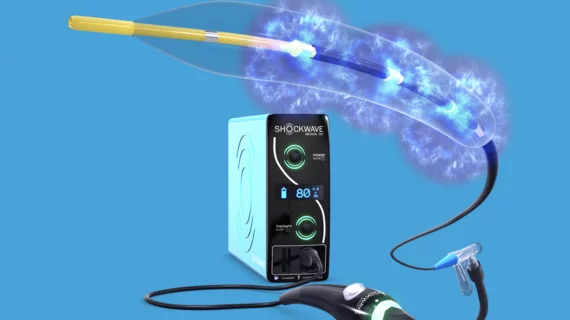Intravascular lithotripsy tied to superior long-term PAD, PCI outcomes at SCAI 2022
Intravascular lithotripsy (IVL), the FDA-cleared technology developed by Shockwave Medical, is associated with better peripheral artery disease (PAD) outcomes after two years than percutaneous transluminal angioplasty (PTA), according to new research presented May 19 at the SCAI 2022, the 45th annual meeting of the Society for Cardiovascular Angiography and Interventions.
This was not the day’s only positive news for Shockwave. A separate SCAI 2022 session focused on IVL’s ability to boost one-year percutaneous coronary intervention (PCI) outcomes among both male and female patients. While previous atherectomy studies have suggested that complications are much more common among female patients, Shockwave’s latest data did not identify such a trend.
Here is a deeper examination of these sessions:
The Disrupt PAD II trial: Intravascular lithotripsy vs. percutaneous transluminal angioplasty for peripheral artery disease
Short-term results from the Disrupt PAD III trial, a multicenter randomized study, found that IVL was superior to PTA for PAD. Procedural success, defined as residual stenosis of 30% or less without flow-limiting dissection prior to the use of a drug-coated balloon (DCB) or stent, was seen in 65.8% of IVL patients and 50.4% of PTA patients.
William A. Gray, MD, a co-principal investigator of the Disrupt PAD III trial, shared a long-term update at SCAI 2022, noting that primary patency was seen in 80.5% of IVL patients after one year and 74.4% after two years. This compares favorably to the 68% and 57.7%, respectively, seen among PTA patients.
“Avoiding unplanned stent implantations allows interventionalists to preserve all their future treatment options should reintervention be necessary,” Gray, co-director of the Lankenau Heart Institute and System, said in a statement. “These new long-term data show that vessel preparation with IVL followed by DCB result in excellent efficacy and durable patency out to two years, and taken together the acute and long-term results reinforce IVL as a preferred vessel preparation strategy for calcified femoropopliteal disease.”
The full analysis from Gray et al. was also published simultaneously in the Journal of the Society for Cardiovascular Angiography and Interventions.[1]
Disrupt CAD III and Disrupt CAD IV: Evaluating the safety and effectiveness of IVL in calcified, stenotic coronary arteries prior to stenting
The Disrupt CAD III and Disrupt CAD IV studies represent recent efforts to further explore the safety and effectiveness of Shockwave’s IVL technology for coronary artery disease (CAD) patients undergoing PCI. According to the data presented at SCAI 2022, a pooled analysis of the Disrupt CAD III and IV studies, IVL is “equally safe and effective” among male and female patients.
The session focused on data from 342 male PCI patients and 106 female PCI patients. The two groups had comparable procedural success and 30-day major adverse cardiovascular event (MACE) rates. Post-IVL serious angiographic complications were also limited among both male (2.6%) and female (2.2%) patients.
One-year MACE rates were also comparable, according to researchers.
“As someone who is dedicating her career to addressing the needs of the most complex patients, I find these results very encouraging,” Katherine Kunkel, MD, MSEd, an interventional cardiologist at Piedmont Heart Institute in Atlanta, said in a separate statement. “Thanks to an increasing focus on the challenges of female patients, which often include atypical symptoms, later presentation with smaller and more tortuous vessels, and possibly an unconscious bias that may be associated with under-treatment, I am confident that we are heading in the right direction to improve outcomes in female patients.”
Kunkel’s team at Piedmont Heart Institute participated in the Disrupt CAD III study.
Related Shockwave and IVL Content:
VIDEO: Shockwave Medical demonstrates faster intravascular lithotripsy at ACC.22
Multicenter trial to evaluate IVL treatment for peripheral lesions below the knee
Shockwave’s IVL technology gains FDA approval for treating advanced coronary artery disease
CMS recommends additional payment for using Shockwave’s IVL technology in hospital setting
Reference:

